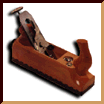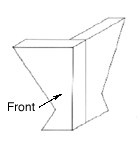 |
|
|
Kitchen Garbage Can

Kitchen garbage containers are usually very ugly and the best approach is usually to buy a small plastic container that will fit under the sink. However, after pondering this problem for a while, I came to the conclusion that there was absolutely no reason why garbage cans cannot be made out of wood. The result was this wooden garbage can. Having completed the project, I then passed it over to my wife who painted and varnished it. Although the project looks complex, it can easily be completed in one weekend and involves no special skills or joints.
Construction
Tools Required: Jigsaw, Sander, Router (optional as it is only needed for the lid), Circular saw (optional, but useful for cutting the straight lines)
Wood Required:
| Description | Qty | Width | Length | Thickness |
| Sides (plywood) | 2 | 11 3/4" (298 mm) | 30 (762 mm) | 1/2" (13 mm) |
| Front/Back (plywood) | 2 | 13 3/4" (349 mm) | 30 (762 mm) | 1/2" (13 mm) |
| Base (plywood) | 1 | 9" (235 mm) | 8" (267 mm) | 1/2" (13 mm) |
| Side edging | 4 | 2 1/2" (64 mm) | 28 1/4" (718 mm) | 1/2" (13 mm) |
| Front/Back edging | 4 | 3" (76 mm) | 28 1/4" 718 mm) | 1/2" (13 mm) |
| Side base edging | 2 | 3 1/2" (89 mm) | 5" (127 mm) | 1/2" (13 mm) |
| Front/back base edging | 2 | 3 1/2" (89 mm) | 6" (152 mm) | 1/2" (13 mm) |
| Lid sides | 2 | 4" (102 mm) | 12 1/2" (318 mm) | 1/2" (13 mm) |
| Lid front/back | 2 | 4" (102 mm) | 14 3/4" (375 mm) | 1/2" (13 mm) |
| Lid top (sides) | 2 | 1 1/2" (38 mm) | 12 3/4" (324 mm) | 3/4" (19 mm) |
| Lid top (front/back) | 2 | 1 1/2" (38 mm) | 14" (356 mm) | 3/4" (19 mm) |
| Lid | 1 | 11 1/4" (286 mm) | 12 1/4" (311 mm) | 3/4" (19 mm) |
Note: The plywood used is birch ply (i.e., the top level of the plywood is a birch veneer). When wood type is not mentioned use Pine.

First, cut the side and front/back plywood to shape. As you can see from the photographs, the garbage can is tapered towards the base and it is necessary to cut the side and front/back pieces of plywood to this shape.
The side pieces should be 30" (762 mm) high, 11 3/4" (298 mm) wide at the top and 8 3/4" (222 mm) wide at the base (therefore, in 1 1/2" (38 mm) from each side so that the taper matches on both sides).
The front/back pieces should be 30" (762 mm) high, 13 3/4" (349 mm) wide at the top and 11" (279 mm) wide at the base (therefore, in 1 7/8" (48 mm) from each side so that the taper matches on both sides).
Note that the front/back of the garbage can is slightly wider than the sides. You can alternatively make the unit square, but the approach used here allows the garbage can to be placed in narrower spaces (a typical problem in a kitchen).
Once you have cut the front/back and side pieces to shape. Glue and nail them together, ensuring that the joint between them is square. The result should be the basic shape of the garbage can. The side pieces should overlap the front/back pieces.
The add the base piece. To do this, cut it to the correct size of 9" x 8" (229 mm x 203 mm) with an angled edge (15 degrees). This involves using a circular saw that can cut miters. However, the alternative approach is to simply cut the piece normally (same dimensions). While the result won't be quite as neat, no one will be able to see it. The base piece should be dropped into the unit from the top and should wedge in position 3/4" above the base of the garbage can.

Now we need to work on the edging pieces. In this particular version of the project, I adopted a distinctive angular approach as I wanted a south western feel to the project (hence the distinctive coloring on the finished project). An alternative suggestion is to use flowing curves instead. Sketch out the rough curve on one of the front/back pieces and then cut out using a jigsaw. Note that the front/back edging pieces are 1/2" (13 mm) wider than the side edging pieces. This is because the front/back pieces overlap the ends of the side pieces (see diagram). Remember that the sides of the garbage can are at an angle (approximately 15 degrees) and the top and bottom of the edging strips must be cut to this angle.
Once you have cut out the shape on one of the edging strips, use this as a template for all of the others so that you can ensure a uniform look and feel to the project. When marking out the side edging strips, remember that they need to be 1/2" (13 mm) narrower.
Once you have cut out all eight edging strips, glue and nail (using small panel pins) the edging strips to the main plywood unit. Remember that the front/back edging pieces should overlap the side pieces. Then add in the base edging pieces (again, cutting the pattern into them first).
The lid unit construction
The lid construction is designed to pull off, allowing a plastic bin liner to be placed in the main unit. When the lid unit is put back on it stops the bin liner from slipping.

To construct the lid unit, firstly cut the side and front/back pieces to the correct lengths. As before, the front/back pieces will overlap the ends of the side pieces. Once cut to the correct length, cut the pieces to the desired shape. Note that for the first 3" (76 mm) in from either side, the lid unit will overhang the side edging pieces of the main unit. Because of this, the first 3" should be cut to a depth of 2 3/4" (70 mm) and left straight (i.e. no pattern), as shown in the diagram. Note that the lid unit is not angled, but instead sits vertically. If you angle the lid construction, you will not be able to slide it on or off the main unit. Because of this, when the lid construction is sitting on the main unit, the lower part of the lid unit overhangs the base unit. This adds to the design, giving it another dimension.
Once you have cut all four pieces, glue and nail them together, ensuring that the construction is square. You can then attach the front/back and side lid top pieces. Note that these are cut to a 45 degree angle so that they butt up against each other neatly (again, see diagram).
Once this is done, you just need to make the actual lid itself. This is an optional construction as some people prefer not to have a lid on the garbage can. The lid is made from a piece of 3/4" (19 mm) thick pine that is 11 1/4" x 12 1/4" (286 mm x 311 mm). Using a router, cut a lip that is 1/4" (6 mm) deep and 3/4" (19 mm) wide all around the underside of the lid. this will allow the lid to rest on top of the lid unit without slipping. Once this is done, round off the edge of the lid, using either a router of by sanding. Finally, add a drawer knob to the center of the lid.
Sand the construction thoroughly. In addition, use a nail punch (or an old nail) to hammer the nails in a little more, so that they are below the surface of the wood. Use wood filler to fill the small hole above the nail. Paint and varnish the unit as desired.